
5 climbing plants that won't damage your walls
To decorate a facade or wall without fear
Contents
We love climbing plants for the charm they bring to a house façade or a boundary wall! However, it must be admitted that sometimes we worry that these lovely climbing lianas might irreparably stain the render and damage the building stones when they are soft, like tuffeau, for example. In this specific case, it is essential to use climbing plants with a soft attachment system that will not harm the structure, and whose vigour can be easily controlled. It will also be important to maintain your gutters and regularly prune your climbing plants to prevent any degradation.
By choosing “gentle” climbing plants with a mode of attachment using voluble or woody climbing stems, you won’t have to fear damaging your walls! Here are some ideas for climbing plants that are among the easiest to establish in any region.
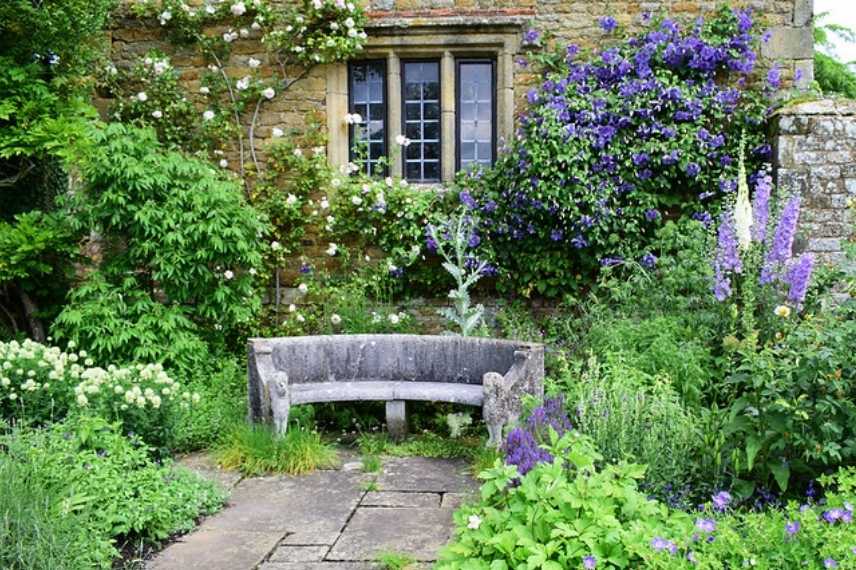
No risk to the walls of this house, beautifully adorned with a climbing rose and a generous clematis! (© Mark)
Hops: natural charm
Humulus lupulus, known as hops, is an impressive climbing plant in many ways: its dense yet light-looking foliage, its summer flowering with bright yellow-green, charmingly shaped small cones, and its substantial dimensions, making it ideal for covering large areas such as a façade or a big wall. Knowing that its climbing system consists of small, flexible tendrils, it’s clear that it won’t harm anything! A deciduous climber with ultra-fast growth, hops can cover around 6 m² in a single season. It is therefore not only effective but also highly ornamental with its fresh green, palmate leaves that are dentate-lobed, and sometimes golden in certain cultivars. Hops have numerous advantages as they are very hardy, never sick, and require almost no maintenance. Its natural look works wonders on a country house, where you can pair it with a rose or a clematis, softening an overly plain façade.
→ My favourite: Humulus lupulus ‘Aureus’ with its lovely soft green.

Humulus lupulus, typical plant and golden cultivar ‘Aureus’ on the right (© Leonora Enking)
Honeysuckle: an unmatched charm and fragrance
The graceful honeysuckles, a touch retro, are often trained on a trellis or pergola, which they beautifully enhance. They are less frequently seen climbing the walls of a house or low walls, yet… they adapt very well to these settings too, with a harmless support system. However, they do need a little assistance by dressing the wall with a fine trellis so they can climb properly with their voluble stems. This is the only requirement to cover a large wall area.
Opt for evergreen honeysuckles if you wish to provide year-round foliage. It’s easy; they are relatively few among the hundred species of honeysuckles, with a very ornamental variety, Lonicera Henryi, being one of the shortest for a small wall. Deciduous honeysuckles are, of course, equally suitable; some are often semi-evergreen depending on the mildness of the climate. Climbing honeysuckles flower between May and September, with some even repeat flowering in autumn, and will be among the first to leaf out in March for the deciduous varieties. All provide birds with some food in winter with their black berries. What an asset for this timeless liana!
A wall exposed to the south or west will be ideal for all honeysuckles that require warmth to offer their delightful fragrances in the evening, but there are also less demanding varieties suitable for an east or even north-facing aspect. Pruning will help limit the thickness of the vegetation, to be done after flowering, primarily to remove dead stems.
→ My favourite: Lonicera periclymenum ‘Graham Thomas’ with its abundant yellow summer blooms on purplish stems.
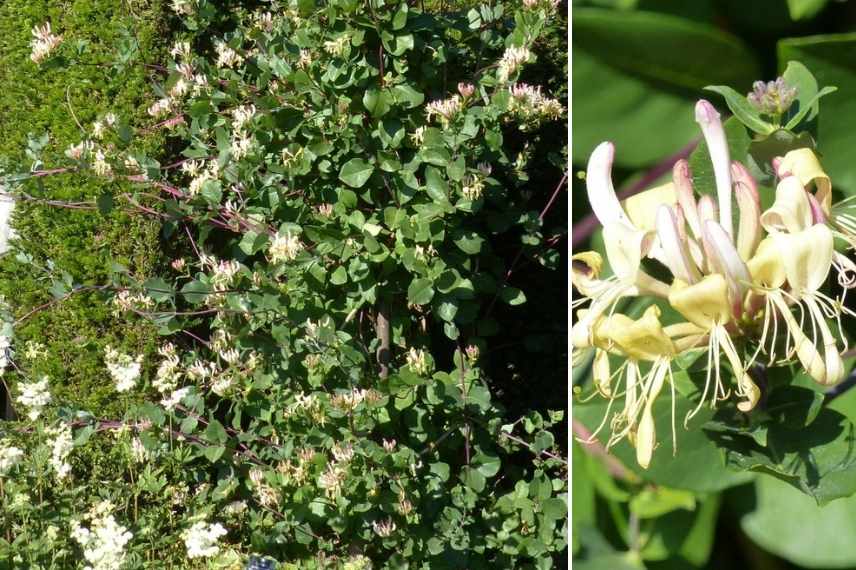
Lonicera periclymenum ‘Graham Thomas’
Discover other Climbers
View all →Available in 0 sizes
Available in 0 sizes
Available in 0 sizes
Available in 0 sizes
Available in 0 sizes
Available in 0 sizes
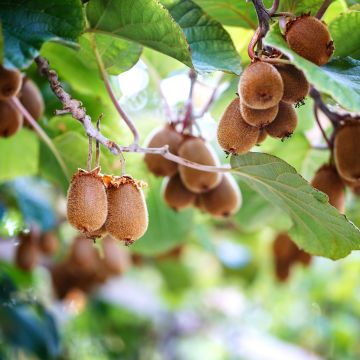
Available in 2 sizes
Available in 1 sizes
Available in 1 sizes
Available in 1 sizes
Climbing roses: like an English garden
Climbing roses need support to develop and fully flourish along the height of a façade or walls. Their stems and branches are more lignified than other climbing plants, and unlike most lianas, they do not possess tendrils or systems that allow them to naturally wrap around supports. We refer to thorny woody climbing stems in roses, which are more or less flexible depending on the variety. They can be trained along a wall using a system of wires, which is very suitable. These are hardy climbers that can thrive anywhere in the hexagon.
These climbing roses will then be stunning subjects for covering part of a wall or façade. Just be careful to choose the right height so you can access your rose easily, simply to prune the faded inflorescences and maintain a beautiful appearance on a house wall, in particular. Therefore, we will mainly consider roses that do not exceed 4 m in height. After that, it really comes down to personal taste regarding colours, as they are countless, ranging from pure white to yellow, peach, all shades of pink, orange, or red, and style, with botanical roses for an English garden or rustic feel, or more sophisticated varieties for contemporary gardens, for example.
→ My favourite; the climbing rose ‘Pink Cloud’, ultra romantic, blooming abundantly with a cloud of deep pink flowers, and repeat flowering.
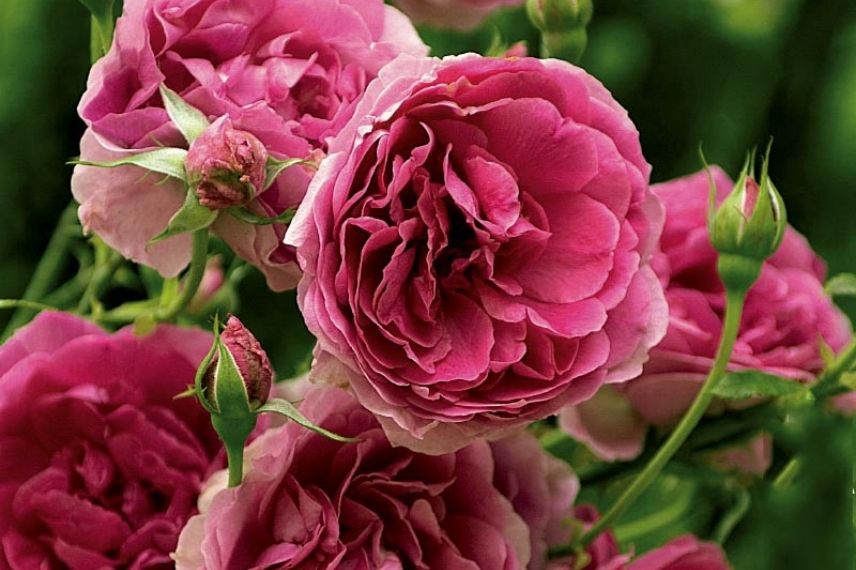
Climbing rose ‘Pink Cloud’
Grape vine: stunning in autumn
Here is an ornamental grapevine that you might not necessarily think of for greening up any wall or dressing a façade in an original way. The grapevine (Vitis vinifera) is indeed very decorative due to its palmatilobate leaves, but also its fruits, of course, and its autumn colouring. It is particularly suited to country houses because of its very natural and wild style.
Unlike the virgin vine, it clings to a support with its tendrils, without the help of climbing roots, making it a very interesting liana that is not harmful to walls. By choosing a medium-sized variety (such as Vitis vinifera ‘Incana’, Vitis vinifera ‘Apiifolia’ or Vitis vinifera ‘Brandt’), it will remain within reach of shears for control in height as well as width.
Like the virgin vine, the grapevine, which is deciduous, colours beautifully in autumn when it is in a well-sunny position, displaying sublime yellow, then red and rust hues. Almost all exposures suit it, but southern and western exposures are essential for its fruits to ripen at the end of summer. You will need to take care with the planting, as the ornamental grapevine has a deep root system. Hardy, it thrives in deeply loosened, calcareous, well-drained soil.
→ My favourite: Vitis vinifera ‘Purpurea’, which adorns itself with purple-red leaves all summer, becoming increasingly colourful in autumn.
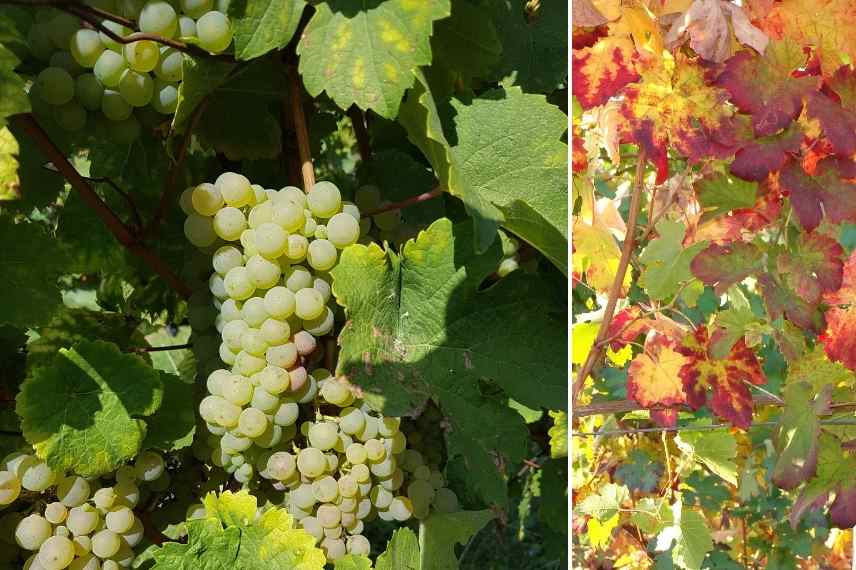
Vitis vinifera, in summer and a lovely autumn colouring emerging on the right
Clematis: flowers from winter to summer!
Finally, among the harmless climbing plants for walls, Clematis are wonders of climbers, with flowering that can be chosen for spring, summer, or even winter!
Having voluble stems, or in many clematis, a system of tendrils at the level of the petioles or voluble pedicels, they are truly beautiful plants that complement a stone or rendered wall. Their advantage over the previously mentioned climbers is that you can plant varieties that will flower in three seasons: in winter with Clematis armandii and Clematis cirrhosa, then in spring primarily with Clematis montana and Clematis alpina, and in summer with numerous Clematis (Clematis viticella, Clematis tangutica, Clematis jackmanii, etc.).
For the most part hardy, easy to grow, and floriferous, you can pair the less vigorous varieties with roses that bloom at the same time, offering a delightful display along a wall or sunny facade! All that’s left is to choose a colour that you like: from stunning blues to deep purples, from very pale pinks to vibrant pinks, from soft yellows to brighter ones and almost oranges, and pure whites… You can also choose between simple or double flowers, small charming ones for a facade, or larger ones for a big wall! Finally, as with honeysuckles, be cautious regarding their dimensions, as some can be very vigorous…
→ My favourite: the Clematis viticella ‘Perle d’Azur’ for a long summer flowering of elegant blue washed with mauve.
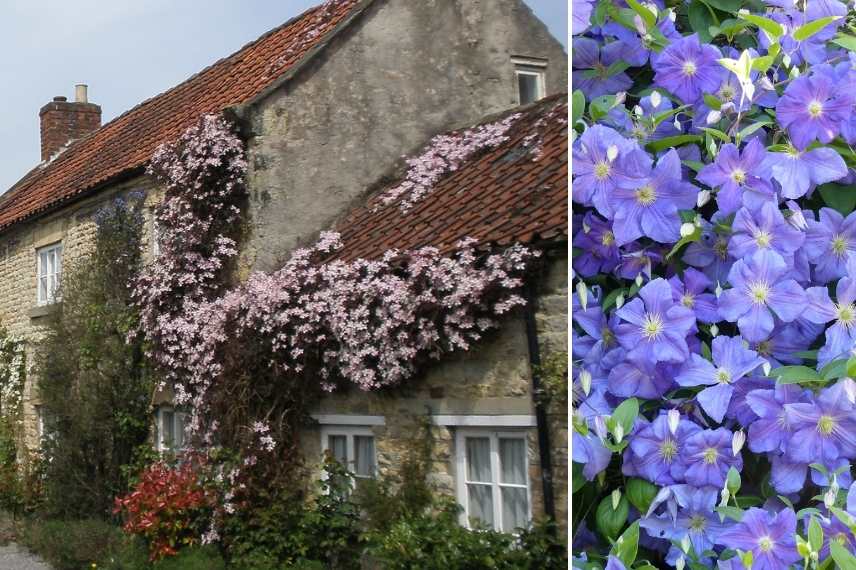
A beautiful spring Clematis montana climbing towards the roof, and to the right Clematis viticella ‘Perle d’Azur’
- Subscribe!
- Contents
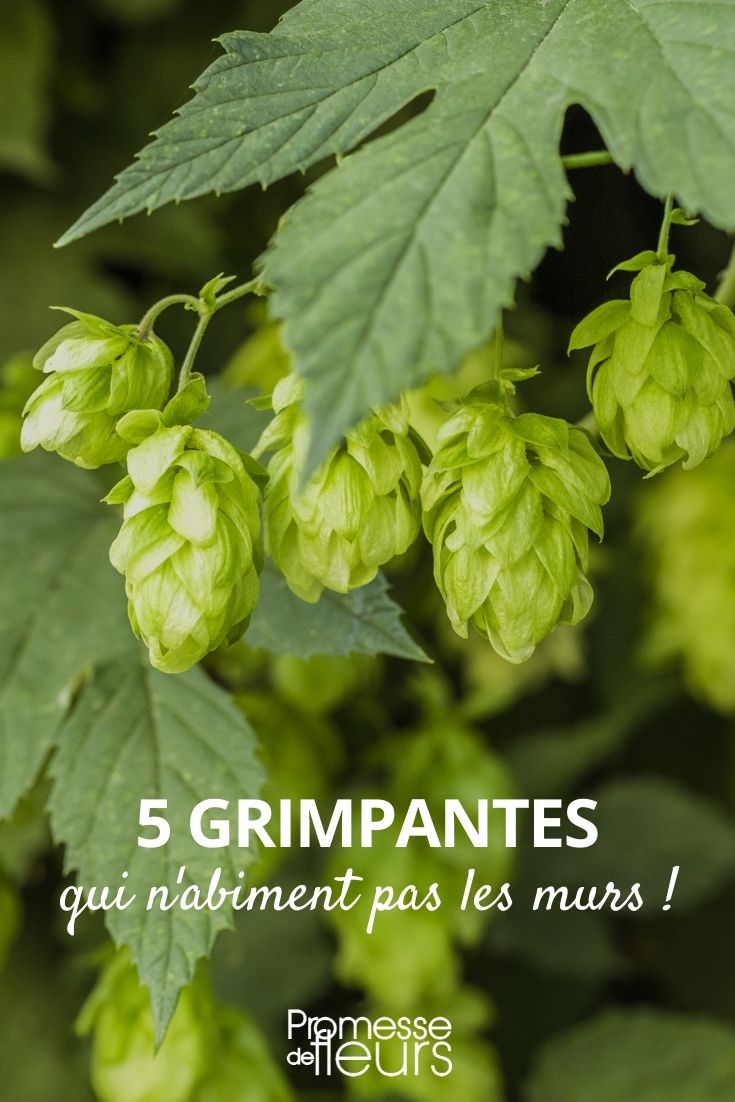































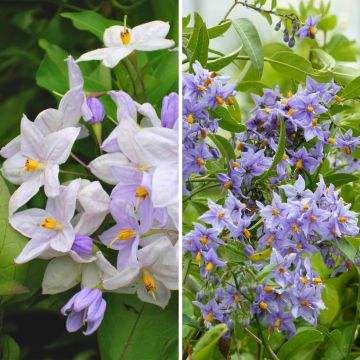

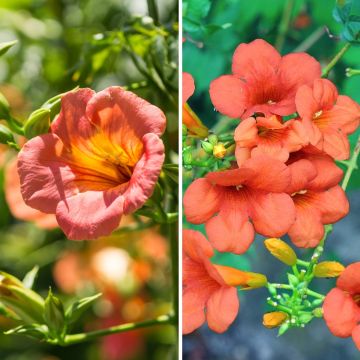

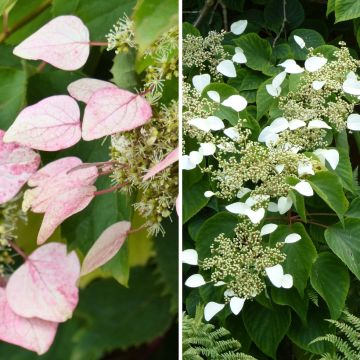


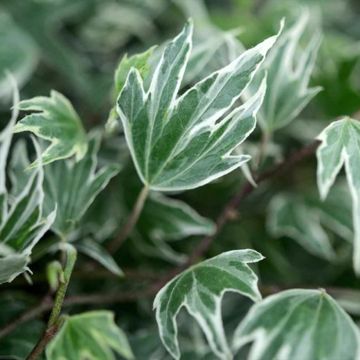
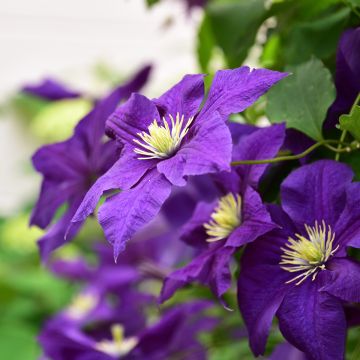
Comments